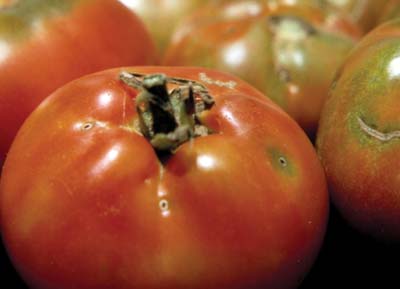
Tomato pinworm, Keiferia lycopersicella, feeding injury to
tomato fruit.
(Photographer: V. Waddill, University of Florida)
Solanaceous (tomato and its relatives) plants are the preferred hosts. Some weeds may also serve as alternate hosts. Damage to the fruit is done when the larvae bore into the fruit leaving a small pinhole. This wound then allows pathogens to enter into the fruit and cause damage. Up to 80% of fruit may be infested in a single growing season. Some chemical control is used but is reliant on good scouting techniques and catching the population at low levels. Sanitation is the best cultural control method. It is essential to avoid planting infested transplants, and to destroy all plant residues at the end of the growing season. Pheromones are available that can interfere with mating and can slow the increase in population size.
Images
To save the Web-optimized images shown below to your hard drive:
|
Click to access Display and Print quality images. |
|
Click to access Display and Print quality images. |
|
Click to access Display and Print quality images. |
|
Click to access Display and Print quality images. |